In Defense of Corum, Elric’s Brother-from-a-Vadhagh-Mother
The Swords Trilogy by Michael Moorcock (Berkley, 1971). Covers by David McCall Johnston.
Wow, I don’t think I could agree less with a column.
Michael Moorcock is one of the tower giants of sword & sorcery and New Wave SciFi; a member of early Conan fandom who by 16 was a published author and editor, and has spent 64 years writing a vast body of work. Most of this work chronicles snapshots of his Multiverse, and the struggles of the Eternal Champion, the tortured, ever-reincarnating hero of the Cosmic Balance in the struggle between Law and Chaos. And, of course, no aspect of that hero is more famous than Elric, Doomed Prince of Melnibone, wielder of the demonic, soul-stealing rune-sword, Stormbringer. No character has perhaps come to symbolize Sword & Sorcery more, other than Conan himself (*maybe* Fafhrd and the Grey Mouser) than Elric.
Only, as Lin Carter wrote in Flashing Swords! #2:
In 1965 followed an Elric novel called Stormbringer, wherein Moorcock made the tactical error of killing off his hero and terminating the series by the simple method of blowing up the universe. Since then Mike has created many another fantasy hero, but he has recently confessed to me that he is tired of making up carbon copies of Elric: hence this story, and the good news that he is back at work, fitting new Elric tales in among the ones written almost a decade earlier…
And so, Moorcock began writing about other incarnations of the Eternal Champion (and retconning some of his earlier characters to become such). It’s quite a pantheon, but some characters are far better known than others. After our Albino Prince, the most famous must be Dorian Hawkmoon, Jerry/Jhary/jeremiah Cornelius, and Erekosë, who alone of the various incarnations, recalls his past lives, and his dark fate. It’s a mixed pantheon to be sure, with a wildly varying quality of work — I find The Jewel in the Skull, first of the Hawkmoon novels, to be one of the best novels Moorcock wrote, but still can’t get through the Jerry Cornelius tales.
But for me, none of the other incarnations quite work the way Corum Jhaelen Irsei, the Prince in the Scarlet Robe does.
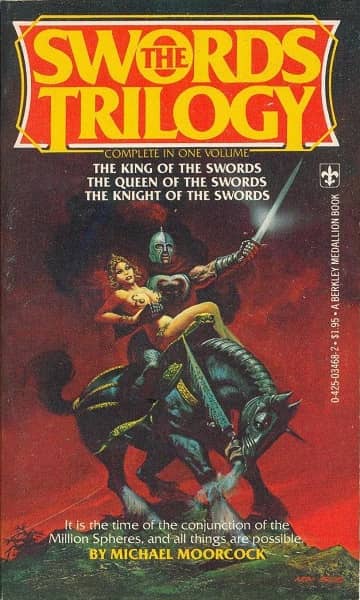 |
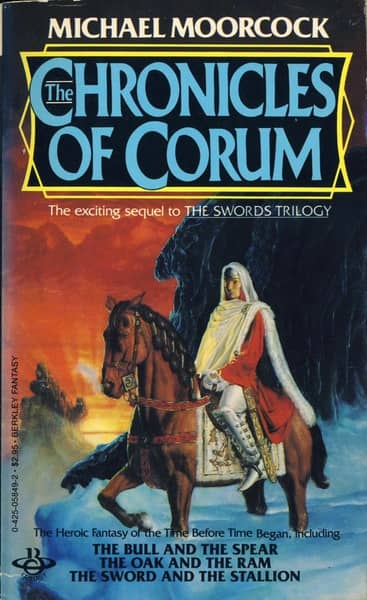 |
The Swords Trilogy (Berkley Medallion, 1977, cover by Ken Barr) and
The Chronicles of Corum (Berkley Medallion, 1983, artist uncredited).
Recently, Steven H Silver wrote a column here called Corum and Me: The Disappointment of the Swords, saying:
I remember enjoying The Swords Trilogy more than The Chronicles of Corum. In the first trilogy, Corum was tortured, had his hand and eye replaced with the hand and eye of gods, and had to defeat Arioch, Xiombarg, and Mabelode, all lords of Chaos, although Arioch was the best known since he was Elric’s patron. My memories of The Chronicles of Corum were of a trilogy in which a watered down character, without the eye and hand of a god, is placed in a reasonably generic Celtic world. It would be interesting to see how my memories stack up.
Spoiler Alert: Not well.
To Silver, the first trilogy is disjointed, the villain’s ill-defined, Corum lacking agency. He also notes that part of one of the novels is a Roshomon-like retread of an Elric tale (and far from the only time this device is used in the cycle):
Finally, Corum must rescue Jhary from the vanishing tower of Voilodion Ghasnasdiak with the assistance of two other aspects of the Champion Eternal in a sequence which also appears in the Elric novel The Sleeping Sorceress (a.k.a. The Vanishing Tower).
He’s right — but also wrong. If the Eternal Champion sequence is a game of three dimensional chess, with the Elric, Hawkmoon and Cornelius cycles the three levels, and the John Daker/Erekose novels a sort of ladder between them, then the Corum novels are the Elric boar’s underside. Corum’s Vadhagh — elfin and long-lived, are a Lawful version of the Melniboneans; children of the same parent race, whose history is ultimately written by the same three Chaos gods — the Sword Lords.
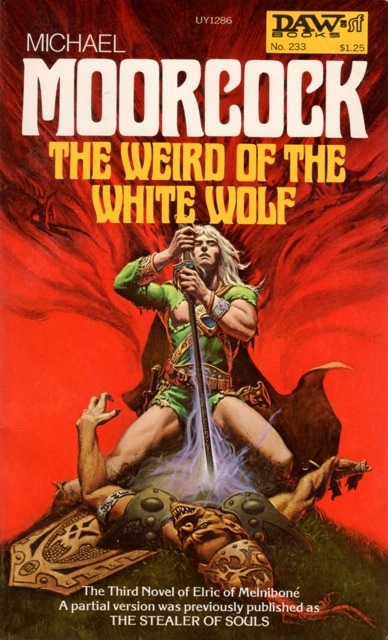 |
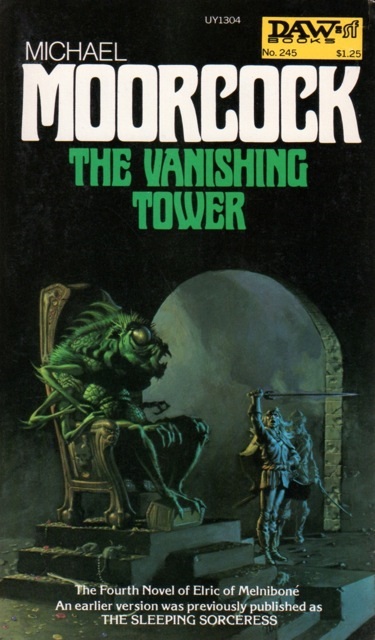 |
Elric, books #3 and 4: The Weird of the White Wolf and
The Vanishing Tower (DAW, 1997, covers by Michael Whelan)
The Melniobneans embraced the patronage of the Sword Lords, especially Arioch, Prince of Swords, and with that patronage became great sorcerers and conquerors. The Vadhagh chose law, and although they won a great war against a rival race long centuries before, have settled into a life of scientific exploration of the multiverse, psychic powers (the ability to shift between the planes) and artistic endeavor. But ironically, though one chose the left-hand path and the other race the right, in both places their long lives and strange aesthetics has produced a people that have retreated inward to personal explorations and ideals, and in their self-absorbed indolence, are a roadblock to the ambitions of the Lords of Chaos, who choose the younger race of Mabden (men) to remove them.
This is a lot more clever than it seems, if we view the tales on a larger scope. The Melniboneans have wrought a world empire, despite being agents of Chaos, but now have come to represent a form of stasis and decay, and are increasingly being supplanted by the men of Pan Tang (who speak Mabden), who both envy, mimic and hate them. The tale of a colonial people embracing the mores and behaviors (and prejudices) of their colonizers is an old and ugly one, and certainly, it was playing out in some very violent ways in the 1960s as the Europeans in many cases freed their colonies by just leaving them to sort it out for themselves.
Elric represents the best and worst of the Melniboneans including their jadedness, ennui and propensity for cruelty and revenge when we meet him. As the saga progresses we see both more of that dark passion as well as a lighter side in his love of his handful of companions and his bride. He is a throw back to an earlier era of Melnibone, which ultimately leads to a kind of terrible apotheosis through a sacrifice of all.
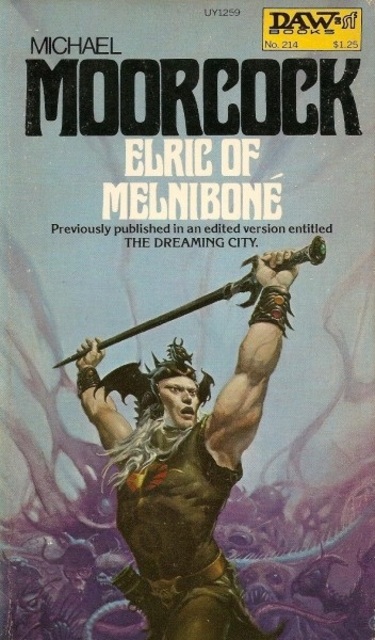 |
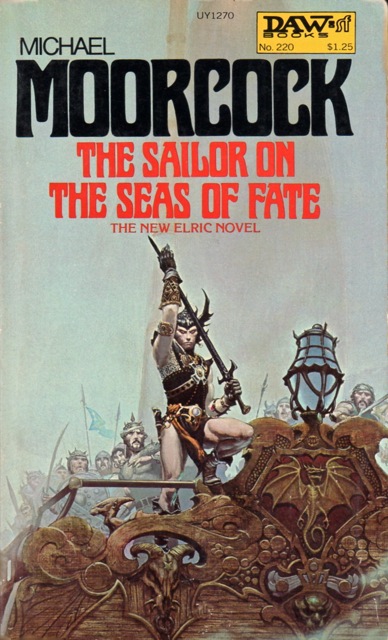 |
The first two books of the Elric saga: Elric of Melnibone and
The Sailor on the Seas of Fate (DAW, 1976, covers by Michael Whelan)
The Vadhagh represent a sort of benevolent indifference, and it shows the price one pays for ignoring the wider world. Corum himself personifies this — educated but naive, well-meaning but self-absorbed. Like all the Vadhagh he truly does not realize how stagnant his existence is, how much his people have grown oblivious of politics, or warcraft or any of the other harsher arts and sciences, until it is too late and he himself is maimed and left to die. It is through meeting a Mabden woman of greater quality and older stock, Rhalina, that he heels in mind and body. So from Men Corum learns both to hate — and to love.
Elric’s tale ends with the final battle between Law and Chaos in which Elric, agent of Chaos, sets into motion a new world, founded on Law. Corum, an agent of Law, sets out to destroy the Lords of Chaos, but does so by invoking the Dead Gods, who decide to destroy Corum’s patrons for good measure “Freeing the Fifteen Planes of gods altogether” — which is a central theme of Moorcock’s world: things most exist in a balance, and men must learn to take responsibility for themselves.
Looked at like this, The Swords Trilogy and Elric saga are both mirror-tales and an interesting twist on the Tuatha de Danaan, since the Lords of Faerie can be seen as both wild and terrifying or wise and urbane. (Something that Tolkien, whom Moorcock reviles, understood well. Indeed, one wonders if the Melniboneans and Vadhagh were not his answer to the Noldor and Sindarin.)
Moorcock’s work probably works best as stand alone stories and novels, because in many cases — indeed, most of Elric’s tales — are fix-ups — short stories repurposed and tweaked to fit together into a single narrative, and it doesn’t always work. The Jewel in the Skull is a great, great book, and The Runestaff ends on an epic note, but the two middle volumes are strange things — fun collections of tales, but narratively just sort of wandering around the world.
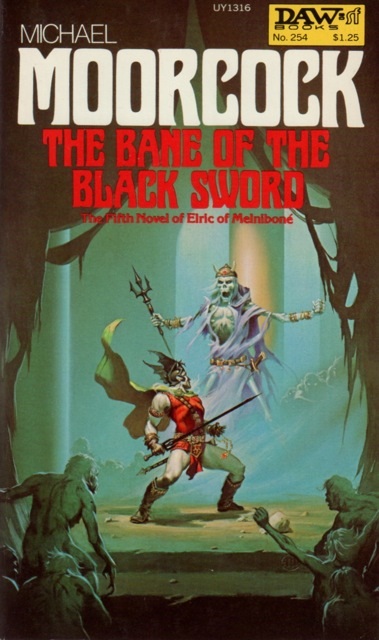 |
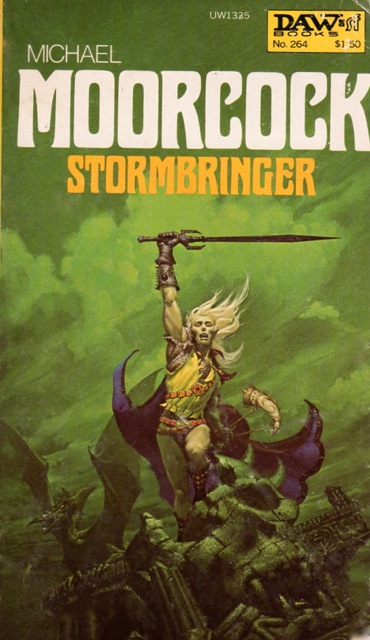 |
Elric, books 5 and 6: The Bane of the Black Sword and Stormbringer (DAW, 1977, Michael Whelan)
Even with Elric, one could really go from Elric of Melnibone (The Dreaming City) to Weird of the White Wolf to Stormbringer, and if it weren’t for Elric picking up a wife along the way, you wouldn’t be missing much for not reading Sailor on the Seas of Fate or The Vanishing Tower — let alone any of the insertions he wrote years later.
The Corum novels are more coherent in this sense, they fit together as a trilogy, actually, two. Unfortunately, the second trilogy, drawing Corum to what is more or less mythical Cornwall, is so far removed from the first novels, and Corum himself so changed, that much like the exceedingly loose Chronicles of Castle Brass or the later Elric novels, they really detract more than they add.
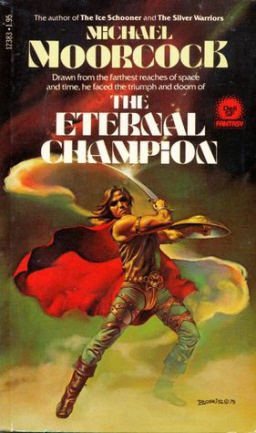 There are plenty of folks more versed in Moorcock’s Multiverse than I, but if you want to give Corum a try, might I suggest that you look at my version of an Eternal Champion Machete Cut?
There are plenty of folks more versed in Moorcock’s Multiverse than I, but if you want to give Corum a try, might I suggest that you look at my version of an Eternal Champion Machete Cut?
1. The Eternal Champion
2. Elric of Melnibone
3. Weird of the White Wolf
4. Stormbringer
5. Knight of Swords
6. Queen of Swords
7. King of Swords
8. The Jewel in the Skull
9. The Mad God’s Amulet
10. The Sword of the Dawn
11. The Runestaff
12. The Quest for Tanelorn
Twelve novels, taken together not much bigger than probably one overstuff BFF by Brandon Sanderson, that will give you everything from a start (beginning in our own world) across multiple timelines and worlds and to a final conclusion of the war between Law and Chaos. You’ll get all of the major players and incarnations of the Champion Eternal, and as you can see, Corum is right in the center of it.
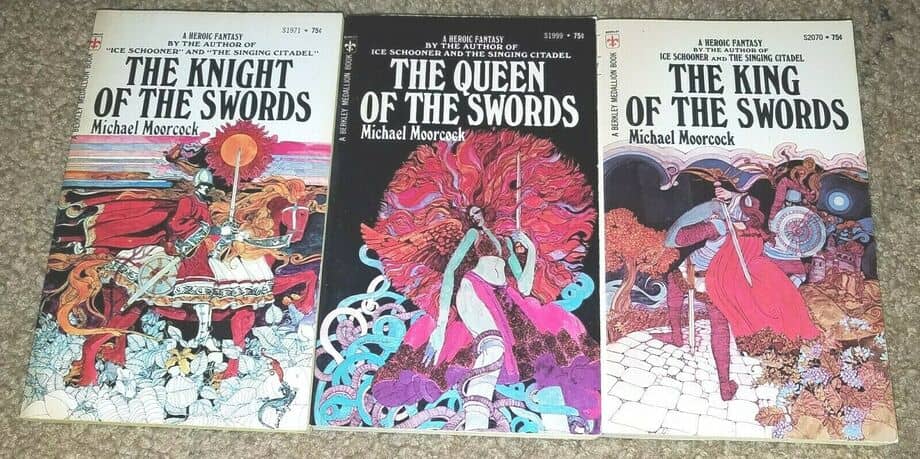
Oooo! Oooo! A fight! A fight!
I actually agree with most of what Greg had written, however, I disagree with his assessment of how successful Moorcock was.
I’ll note that Greg is responding to an article I wrote about the first trilogy only (the article about the second trilogy is forthcoming).
The idea that the Vadhagh are the Lawful side of the Melnibonean Chaos is definitely in the novels, I just think that Moorcock could have done a better job in depicting it. I think one of the issues is that the Lords of Law are depicted as extremely weak (which makes sense given the Vadhagh’s current position in their world), but also that the Lords of Chaos are powerful (more powerful than in the Elric novels) but I found them less interesting than in the Elric novels.
That said, Moorcock’s treatment of the Gods (of both Law and Chaos, as well as Rhynn and Kwll) set up a good part of the next Corum trilogy.
I will be intrigued in how closely we align in our view of the second trilogy. I haven’t read them in years, but my general feeling was that they would have been perfectly serviceable fantasy, if someone other than Corum was the character. Devoid of the Hand and Eye, Rhalina and his various cohorts, Corum is more just a vehicle for the novels than the character of the previous trilogy. They ultimately are meant to decidedly tie up the Law and Chaos clash in Corum’s timeline(s) but they really didn’t feel linked — just like the later Hawkmoon books really don’t either. In fact, I include Quest for Tanelorn in my reading order because it is definitely the closet to a “conclusion” we get, but it works far better in that context than it does a novel about Hawkmoon.
I’ve got nothing to add to the conversation, other than an observation that I really miss the cover art from the 70’s.
Elric, Corum – whatever. They’re all just trimming. The Warrior in Jet and Gold is really the best character of them all.
(Finds himself blocked by the firewall after that comment).
‘The Oak & the Ram’ was my introduction to Moorcock’s eternal champion. Maybe that’s why I still have such vivid memories of reading about this exotic character with his eye-patch, galloping through some frozen landscape and encountering characters like Prince Gaynor the Damned, (his armour glimmering a dozen different rainbow hues) or creatures like the Fhoi Myore – the hideous giants responsible for the cataclysm.
So I guess I’m biased about the merits of the second trilogy. I read the first trilogy some years later and enjoyed it every bit as much as the second, even though they are tonally very different. In fairness, both draw on Irish mythology – Nuada of the Silver Hand was King of the Tuatha de Dannan (an elvish race not unlike the Vadhagh) and his adversaries were the sea-dwelling and hideous Formorians – although maybe the first series draws more heavily on Welsh mythology? It’s been a while since I last read it.
Moorcock fight! Seriously, though, these and the sequel trilogy are my favorite sustained Moorcock series.
I haven’t read these for over 40 years, but I remember liking them very much. Maybe it’s time for a reread; I might even be able to get it done in a reasonable amount of time, because there’s one great virtue here – a whole six volume series that burns fewer pages than one book in some other people’s epics.
In some respects, my favorite Moorcock character. Having first come to Moorcock by way of the Marvel Elric/Conan crossover, it was cool to see Xiombarg and Gaynor in prominent roles. Also, a cameo by the Queen in Green, Terhali!
Thank you for the interesting take on one of my all time favorite characters in Fantasy literature. Corum will always be the red headed step child to Elric, but is a more interesting character in my opinion. Nowhere near as powerful as Elric, without Spell or heavily enchanted blade or relic (Eye of Rhynn and Hand of Kwll were short lived), he survived on his wits and dogged determination, although he could sure be a little whiny. Both Corum trilogies well worth the read, and surely very different in tone. If you enjoy Celtic Lore, you will enjoy The Chronicles, an excellent if not overly fatalistic tale. If you like Corum and Moorcock, I strongly suggest you read Poul Anderson’s The Broken Sword. For me, the finest Sword and Sorcery tale of classic bent available. This story’s obvious influence on Moorcock’s Elric and Corum cannot be denied. What a story…
Glad you enjoyed. “The Broken Sword” and “Three Hearts and Three Lions” by Anderson are seminal fantasy, IMO, both clearly leaving a mark on Moorcock (as did Haggard’s “Eric Brighteyes” I suspect).